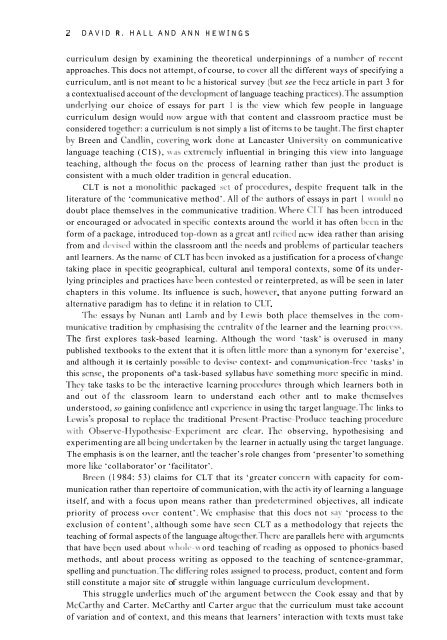Download - Search
Download - Search
Download - Search
You also want an ePaper? Increase the reach of your titles
YUMPU automatically turns print PDFs into web optimized ePapers that Google loves.
2 DAVID R. HALL AND ANN HEWINGScurriculum design by examining the theoretical underpinnings of a number of reccntapproaches. This docs not attempt, of course, to cover all the different ways of specifying acurriculum, antl is not meant to be a historical survey (but see the Feez article in part 3 fora contextualiscd account of the tlevelopmcnt of language teaching practices).’l’hc assumptionunderlying our choice of essays for part 1 is the view which few people in languagecurriculum design ~ ould now argue Lvith that content and classroom practice must beconsidered togethcr: a curriculum is not simply a list of items to be taught.Thc first chapterliy Breen and Candlin, covering work done at Lancastcr Univu-sity on communicativelanguage teaching (CIS), \vas extremely influential in bringing this \-iew into languageteaching, although the focus on the process of learning rather than just the product isconsistent with a much older tradition in gencral education.CLT is not a nionolithic packaged set of procedures, tlespitc frequent talk in theliterature of the ‘communicative method’. All of the authors of essays in part 1 ~.ould nodoubt place themselves in the communicative tradition. Where CUT has heen introducedor encouraged or atlvocatctl in specific contexts around the xvorld it has often been in thcform of a package, introduced top-hvn as a grcat antl rc+ietl ncw idea rather than arisingfrom and de\+ictl within the classroom antl the needs and problcms of particular teachersantl learners. As the name of CLT has hccn invoked as a justification for a process of changetaking place in speci tic geographical, cultural and temporal contexts, some of its underlyingprinciples and practices have lieen contested or reinterpreted, as \vi11 be seen in laterchapters in this volume. Its influence is such, howwer, that anyone putting forward analternative paradigm has to detinc it in relation to CLI’.The essays by Nunan antl Lamb and by I.c\vis both place themselves in the communicativctradition by cmphasising the ccntralitv of the learner and the learning proThe first explores task-based learning. Although the \vord ‘task’ is overused in manypublished textbooks to the extent that it is often little more than a synonjm for ‘exercise’,and although it is certainly possible to tlcvisc, context- and c.omnlunic.ation-frcc ‘tasks’ inthis sense, the proponents of‘ a task-based syllabus have something more specific in mind.Thcy take tasks to be the interactive lcarning procedures through which learners both inand out of the classroom learn to understand each other antl to make thcmselvesunderstood, so gaining conlitlencc antl cxpcricncc in using the target language.l’hc links toLewis’s proposal to replace thc traditional Prescnt~Practisc~Protlucc teaching procedurcwith Ohserve-Ilypothcsisc~Expcriment arc clear. l‘hc observing, hypothesising andexperimenting are all being undertaken by the learner in actually using the target language.The emphasis is on the learner, antl the teacher’s role changes from ‘presenter’ to somethingmore like ‘collaborator’ or ‘facilitator’.Ihcn (1984: 5 3) claims for CLT that its ‘grcatcr concern lvith capacity for communicationrather than repertoire of communication, with the acti\ ity of learning a languageitself, and with a focus upon means rather than prctlctcrminctl objectives, all indicatepriority of process ovcr content’. We cmphasisc that this docs not say ‘process to theexclusion of content’, although some have seen CLT as a methodology that rejects theteaching of formal aspects of the language altogcthcr.Thcrc are parallels here with argumcntsthat have been used about \vholc-w ord teaching of rcading as opposed to phonics-hasedmethods, antl about process writing as opposed to the teaching of scntcnce-grammar,spelling and punctuation.Thc differing roles assigned to process, product, content and formstill constitute a major sitc of struggle hvithin language curriculum tievclopment.This struggle untlerlics much of’ the argument between the Cook essay and that byMcCarthy and Carter. McCarthy antl Carter argue that the curriculum must take accountof variation and of context, and this means that learners’ interaction with texts must take


